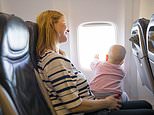
Experts are warning parents not to put infants on their laps when flying after a panel blew off on an Alaska Airlines plane at 16,000 feet.
The National Transportation Safety Board (NTSB) and Federal Aviation Administration (FAA) said if an infant were sitting on their parent’s lap near the window, they would have been swept out of the plane.
The agencies are urging parents to purchase a separate seat for their children despite guidelines allowing those under two years old to fly free following last week’s ‘truly terrifying’ incident.
‘The safest place for a child under age two is an approved child-restraint system or device, not an adult’s lap,’ the FAA told Dailymail.com.
Experts warn parents against their child sitting on their lap while flying over safety concerns
Parents are not currently required to buy separate seats for infants and are allowed to hold them in their laps, but protecting the child could outweigh the financial toll of spending more money to fly, according to the FAA and NTSB.
When asked how the FAA responds to parents who might argue that they can’t afford to buy their infant a seat, the FAA only said: ‘For every rule, the FAA is legally required to conduct a cost-benefit analysis to show that the benefits of the proposal exceed the costs.’
Alaska Airlines flight 1282 was forced to land when a window panel blew out on the Boeing 737 Max 9 plane shortly after take-off.
Debris from two cellphones, a seat back, and a tray table were sucked out of the gaping hole and were later found on the ground in the Portland area.
Following the incident, all Boeing 737 Max 9 planes were grounded while the FAA and NTSB investigated what caused the panel to blow out.
Federal investigators reported that a preliminary inspection revealed that loose bolts may be at fault after United and Alaska Airlines said they found loose parts in the door panels during Boeing 737 Max 9 inspections.
The number one cause of pediatric airplane injuries is unexpected turbulence, but the Alaska Airlines incident brought renewed concerns about unsecured infants to the forefront of aviation safety.
There were three infants on board the Alaska Airlines flight, but none were sitting in the aisle where the window blew out.
A window panel blew out on an Alaska Airlines flight, prompting concerns that an unsecured infant could have been sucked out of the plane
The panel flew off the plane while it was at 16,000 feet. Toys, phones and clothes were sucked into the night after the plug door ‘departed the aircraft’ causing instant decompression with 171 passengers aboard Flight 1282 on Friday evening
‘If there had been a passenger holding a kid close to where that panel blew off, the explosive force was such that a kid being held would have been torn from the hands of their parents, and they would have been sucked out the plane,’ Kwasi Adjekum, an assistant professor at the University of North Dakota’s Department of Aviation told The Washington Post.
‘The practice of holding kids on your lap, especially for takeoff and other vulnerable phases of flight — it’s highly frowned upon and discouraged,’ Adjekum added.
Dailymail.com also asked the FAA whether it should focus on airplane safety first rather than resorting to parents paying for an extra seat.
The FAA said, ‘ The FAA’s priority is keeping the public safe.’
The agency issued an Emergency Airworthiness Directive to Boeing for its 737 Max 9 airplanes, grounding them until all ‘applicable corrective actions have been performed.’
Anthony Brickhouse, an aerospace safety professor at Embry-Riddle Aeronautical University, questioned why children are required to be in a car seat if they’re under a certain weight in a vehicle, but parents are permitted to hold them on their lap on a commercial flight.
‘That, to me, is just a gap in the system,’ Brickhouse told The Post, adding: ‘And unfortunately, in safety, a lot of times, changes aren’t made until there’s a tragedy.’
The National Transportation Safety Board (NTSB) and Federal Aviation Administration (FAA) said if an infant were sitting on their parent’s lap near the window, they would have been swept out of the plane
Yet, tragedies have frequently occurred as early as the 1970s, prompting the NTSB and FAA to require airlines to allow aviation-approved child seats on board in 1990.
The NTSB sent a letter to the FAA in 1990, asking the agency to approve aviation car seats, citing numerous in-flight emergencies that resulted in infant injuries or fatalities.
‘The problems experienced by these three parents graphically illustrate the impossibility of holding onto an infant during a crash,’ the NTSB said at the time.
The FAA proposed a regulation in 2003 requiring children under two years old to be in infant restraint seats on airplanes.
However, pediatricians argued it would be counterproductive and would ultimately cause more fatalities than it prevents.
Pediatricians claimed that more deaths resulted from automobile crashes than planes, and forcing parents to purchase an extra ticket for their child would cause parents to opt to drive to their destination instead of flying.
In light of the recent Alaska Airlines fiasco, the NTSB and FAA appear to be revisiting this idea, although no proposed regulations have been made.
Adjekum said U.S. regulators expressed concerns that tethering a child to a seat would slow down plane evacuations in case of emergency and could be a ‘potential obstruction hazard’ for other passengers.
Dailymail.com has reached out to the NTSB and several airlines for comment.
Source link
CHECK OUT: Top Travel Destinations
READ MORE: Travel News



